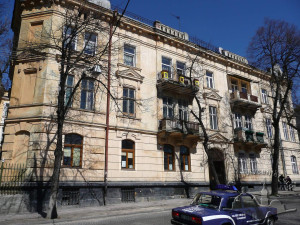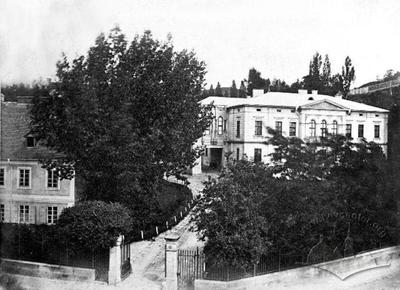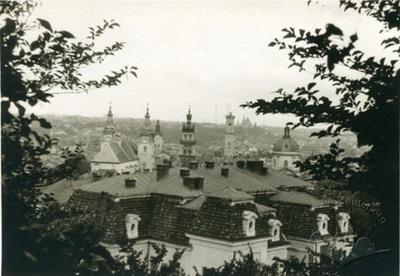
Vul. Lysenka, 15 – military building (former Dzieduszycki palace) ID: 1544
The palace situated on Lysenka street 15 was reconstructed from a villa by architect Wincenty Rawski Sr. at the cost of a well-known family of Dzieduszycki who planned to bring their unique collection of books and works of art from the village of Potorytsya near Sokal to Lviv. Among the exhibits, there was the world famous Mykhalkiv (Michałków) gold treasure dated to the 8th-7th centuries B.C., with a total weight of 7 kg. According to the resolution of the Regional Executive Committee of the Lviv Region no. 130 dated 26 February 1980, the palace on Lysenka street 15 was entered in the Register of local monuments under protection number 157.
Story
Before 1849 – the Winiarz’s villa is built.
1856-1860 – Neoclassicist-style
utility buildings are constructed under a project designed by architect
Wincenty Rawski Sr.
1871 – a small caretaker’s
room is added to the palace’s western wing.
1873 – a great
reconstruction and development of the palace under a project designed by
architect Józef Engel: the palace’s main part is enlarged by
adding two wings on the west and on the east; the façades are designed in the
Neoclassicist style.
1878 – alabaster portals
are made (sculptor Leonard Marconi).
1892 – the palace is
connected to the city service lines (engineer Robert Goeber).
1880s-1890s – a park is laid out
with ornamental and rare species of trees.
1893-1894 – a single-storied
utility building with a stable, a cart shed, toilets, and an ice-house is
built.
1902 – the palace is
developed and extended under a project designed by architect Władysław Halicki: the third floor is added, a new roof with
lucarnes is made, an additional staircase is arranged; the façades between the
second and third floors are decorated with bas-relief portraits of the
Dzieduszycki family members.
1903 – the single-storied
office building is dismantled; a reconstruction of the western wing, which was
extended and raised, is carried out under a project designed by Władysław Halicki.
1910 – a hydraulic lift is
arranged in the palace.
The former palace is situated on the southern slope of the Zamkova (Castle) mountain, within the old Halytske suburb. It was commissioned by the Dzieduszycki family. This noble family of Ukrainian origin (the Sas coat of arms) comes from the villages of Velyki Didushytsi and Mali Didushytsi located not far from the town of Stryi; their line of descent is drawn from the time of the Galician-Volhynian principality. The oldest documents concerning the Dzieduszycki family are dated to 1263 and 1274; till the mid-15th century they were written exclusively in Ukrainian. Members of this family are known as statesmen, maecenases, scientists and scholars, as well as artists. In the mid-18th century the Dzieduszyckis were polonized and became Roman Catholics instead of Greek Catholics. After Galicia was annexed by Austria in the late 18th century the Dzieduszycki were granted a count title. One of the Dzieduszycki family’s branches, that of Potorytsya, was founded by Józef Kalasanty (1772-1847), the son of Tadeusz Gerwazy (1724-1777). It was Józef Kalasanty who formed the renowned Potorytsya library. The other two branches of the Dzieduszycki family were founded by Józef’s elder brothers: Antoni Bazyli (1757-1817) and Walerian Wiktoryn (1754-1832); Maurycy Ignacy (1813-1877), a well-known Lviv historian, was the latter’s grandson. Włodzimierz Ksawery Tadeusz (1825-1899), the son of the Potorytsya branch founder, was a renowned maecenas who created and owned one of the best natural museums of Galicia situated in Lviv on Teatralna street 18.
In 1853 Włodzimierz Dzieduszycki and his wife, Alfonsyna Dzieduszycka, nee Miączyńska, bought from E. Winiarz a villa with a large plot located at the foot of the Vysoky Zamok mountain. The Winiarz’s villa was built before 1849 in the depth of the plot and was designated on the 1849 cadastral map of Lviv (conscription no. 45 4/4, topographic no. 3087).
Already in 1853 the Dzieduszyckis moved the family collection and library from the village of Potorytsya near Sokal to the newly purchased villa. The Potorytsya library numbered 55 thousand volumes, including 230 manuscripts and parchments. Apart from books, the Dzieduszyckis also brought there a large collection of works of art: 2000 engravings, 400 geographical maps, over 1000 portraits etc.
The Dzieduszyckis reconstructed their villa as a palace in 1856 under a project designed by architect Wincenty Rawski Sr. It was also under his projects that several Neoclassicist-style utility buildings were constructed on the palace territory in 1860.
In 1870 countess Alfonsyna purchased a piece of the slope situated between the palace and the shooting gallery. In 1871 a small caretaker’s room was added to the western wing’s northern end. In 1873 a great reconstruction and development of the palace started under a project designed by architect Józef Engel. The palace’s main part was enlarged by adding two wings on the west and on the east; the façades were designed in the Neoclassicist style. In 1878 countess Alfonsyna commissioned Leonard Marconi, a well-known sculptor, to make alabaster portals in the building. In the 1880s-1890s a park was laid out where ornamental and rare species of trees were planted.
In 1893-1894 a single-storied utility building with a stable, a cart shed, toilets, and an ice-house was built on the grounds situated on the neighbouring slopes and purchased by the Dziduszyckis. Their office was located in a big single-storied building standing to the northwest of the palace.
The palace was most significantly developed and extended in 1902. It was then that, under a project designed by architect Władysław Halicki, the third floor was added, an additional staircase was arranged and a new roof with lucarnes was made. It was also at that time that the palace’s façades between the second and third floors were decorated with bas-relief portraits of the Dzieduszycki family members placed in garlanded oval niches; the portraits may have been created by Antoni Popiel, a noted sculptor. In 1903 the single-storied office building was dismantled, and a reconstruction of the western wing was carried out under a project designed by Władysław Halicki; the wing was extended and raised. Apart from the roof, it is in this condition that we can see this part of the palace today. In 1910 Alfonsyna Dzieduszycka, after the death of her husband, count Włodzimierz, had a hydraulic lift arranged which was made by the Z. Rudakowski’s technical bureau. In the interwar period an art gallery was organized in the palace which was given the name of the Dzieduszyckis. The collection consisted of paintings and graphic works as well as archeological findings. In 1940 the gallery was closed by the new authorities; its collection was divided between different new city museums (Arts Gallery, Lviv Historical Museum, Museum of Ethnography and Art Crafts). A part of exhibits disappeared, including the world known Mykhalkiv gold treasure from the 8th-7th centuries B.C. with a total weight of 7 kg.
The palace and administrative building were owned by the descendants of the Dzieduszycki family till 1939. After the World War II a department of the Soviet security service was located in the palace and in a part of the building no. 17; since 1991 these premises have been occupied by the Military Counterintelligence Department of the Security Service of Ukraine in the West region. The stable premises were turned into apartments.
Architecture
The three-storied building no. 15 on Lysenka street is a palace consisting of residential and cultural-educational premises. It is built of brick on stone foundations and has cellars passing into semi-basements due to the sloping ground. This U-shaped building is plastered and has two two-storied wings (the western one is elongated). The main building and the eastern wing are covered with a high curb roof having lucarnes.
The whole volume and planning composition of the palace is dominated by the main three-storied building adjoined by two-storied wings. The building’s idea is expressed in its architecture as the palace belongs to the Historicist style. The French Neo-Renaissance motifs and some Neo-Baroque details are used in the decoration of the façades, which was typical of the palace construction in the second half of the 19th century. The main façade has a symmetrical and centrally axial composition. The main axis is emphasized by a three-axis avant-corps topped with a triangular pediment whose tympanum is embellished with a stylized plant décor and has a round window on the axis. The building’s ground floor is accentuated by linear rustication; the upper floors are divided vertically by lesenes with rounded angles. All windows are decorated with shaped trimmings; the second floor windows have linear pediments. The main façade is emphasized by bas-relief portraits which can be seen in garlanded oval niches placed between the second and third floors windows. These portraits depict five distinguished figures of the Dzieduszycki family marked with the initials: Tadeusz Gerwazy, Włodzimierz Ksawery Tadeusz, Antoni Bazyli, Józef Kalasanty, Maurycy Ignacy. The portraits are repeated on the main building’s lateral façade.
The main building’s west (lateral) façade has three axes and is accentuated by a triangular pediment similar to that of the main façade. The extreme axis is emphasized by a three-arched entrance and a stone balcony above it, supported by four cantilevers.
The western wing has three floors and a rounded southwestern corner. Its architectural design belongs to the Neo-Baroque style as its ground floor is emphasized by board rustication and the façade is crowned with a shaped cornice. The west façade has a symmetrical composition; its central axis is accentuated by an avant-corps with a balcony supported by cantilevers. The semicircular second floor windows are decorated with shaped portals having segmental tops.
The rear façades of the main building and wings are solved in the Neo-Baroque style expressed in shaped window trimmings, horyzontal cornices, the east wing’s balcony, lucarnes.
Related buildings and spaces
People
Alfonsyna Dzieduszycka, nee Miączyńska – a countess, Włodzimierz Dzieduszycki’s wife, who owned the palace on
Lysenka street.
Antoni Bazyli
Dzieduszycki(1757-1817) – Józef’s brother, the founder of the Dzieduszycki family branches;
decorated with the order of St. Stanislaus and with the order of the White
Eagle; a member of the Isis Shrine masonic lodge.
Antoni Sulima Popiel (1865-1910) – a well-known
sculptor and educator; the author of the plastic decorations on the palace’s
façade.
Walerian
(Walery) Wiktoryn Dzieduszycki (1754–1832) – Józef’s brother, the founder of the Dzieduszycki family
branches; the grandfather of Maurycy Ignacy (1813-1877), a well-known Lviv
historian.
Wincenty Rawski Sr. (1810-1876) – an architect who developed the
Dzieduszyckis’ palace.
Władysław Halicki (1850-1939?) – an architect who designed a project
of the most significant development and extension of the palace.
Włodzimierz
Ksawery Tadeusz Dzieduszycki(1825-1899) – a renowned maecenas
who created and owned one of the best natural museums of Galicia situated in
Lviv on Teatralna street 18; the son of the founder of the Potorytsya branch.
Dzieduszyckis
(Dzieduszyccy, in Polish spelling) – a noble
family of Ukrainian origin (the Sas coat of arms) which comes from the villages
of Velyki Didushytsi and Mali Didushytsi located not far from the town of
Stryi; their line of descent is drawn from the time of the Galician-Volhynian
principality. The oldest documents concerning the Dzieduszycki family are dated
to 1263 and 1274; till the mid-15th century they were written
exclusively in Ukrainian. Members of this family are known as statesmen,
maecenases, scientists and scholars, as well as artists. In the mid-18th
century the Dzieduszyckis were polonized and became Roman Catholics instead of
Greek Catholics. After Galicia was annexed by Austria in the late 18th
century the Dzieduszycki were granted a count title.
E. Winiarz– the owner of the
villa situated at the foot of the Vysoky Zamok mountain and purchased by Włodzimierz Dzieduszycki.
Z. Rudakowski – a manager of the
technical bureau which arranged a hydraulic lift in the palace.
Józef Engel
– an architect who developed the palace.
Leonard Marconi (1835-1899) – a
renowned Lviv sculptor of the Historicism period and a teacher; the author of
the plastic decorations on the palace’s façade.
Maurycy
Ignacy Aleksander Dzieduszycki (1813–1877) – well-known Lviv historian, Walerian Wiktoryn Dzieduszycki’s grandson.
Robert Goeber – an engineer who
connected the palace to the city service lines.
Tadeusz Gerwazy
Dzieduszycki (1724–1777) – the father of Józef Kalasanty Dzieduszycki who formed the Potorytsya collection.
Józef Kalasanty
Dzieduszycki (1772–1847)
– the
founder of the Potorytsya branch who formed the Potorytsya collection of books
and works of art.
Sources
- State Archive of Lviv Oblast (DALO): 2/1/7839.
- DALO: 2/3/1133.
- Central State Historical Archive of Ukraine in (CDIAL). Item 186/8/829 (Lviv Cadastral Plan of 1849).
- Scientific-Technical Archive of Ukrzahidproektrestavratsiya Institute. The Architectural Monument’s Passport, 2011 р.
- Maurycy Dzieduszycki, Kronika domowa Dzieduszyckich (Lwów, 1865).
- Світлана Лінда, “Архітектура історизму”. Архітектура Львова. Час і стилі. XIII–XXI ст., 363-364 (Фото Ю. Едера 1873 р.).



